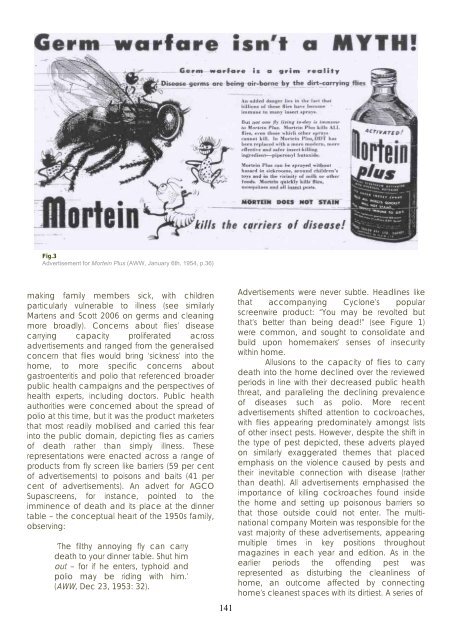Marketing Animals - Antennae The Journal of Nature in Visual Culture
Marketing Animals - Antennae The Journal of Nature in Visual Culture
Marketing Animals - Antennae The Journal of Nature in Visual Culture
Create successful ePaper yourself
Turn your PDF publications into a flip-book with our unique Google optimized e-Paper software.
Fig.3<br />
Advertisement for Morte<strong>in</strong> Plus (AWW, January 6th, 1954, p.36)<br />
mak<strong>in</strong>g family members sick, with children<br />
particularly vulnerable to illness (see similarly<br />
Martens and Scott 2006 on germs and clean<strong>in</strong>g<br />
more broadly). Concerns about flies’ disease<br />
carry<strong>in</strong>g capacity proliferated across<br />
advertisements and ranged from the generalised<br />
concern that flies would br<strong>in</strong>g ‘sickness’ <strong>in</strong>to the<br />
home, to more specific concerns about<br />
gastroenteritis and polio that referenced broader<br />
public health campaigns and the perspectives <strong>of</strong><br />
health experts, <strong>in</strong>clud<strong>in</strong>g doctors. Public health<br />
authorities were concerned about the spread <strong>of</strong><br />
polio at this time, but it was the product marketers<br />
that most readily mobilised and carried this fear<br />
<strong>in</strong>to the public doma<strong>in</strong>, depict<strong>in</strong>g flies as carriers<br />
<strong>of</strong> death rather than simply illness. <strong>The</strong>se<br />
representations were enacted across a range <strong>of</strong><br />
products from fly screen like barriers (59 per cent<br />
<strong>of</strong> advertisements) to poisons and baits (41 per<br />
cent <strong>of</strong> advertisements). An advert for AGCO<br />
Supascreens, for <strong>in</strong>stance, po<strong>in</strong>ted to the<br />
imm<strong>in</strong>ence <strong>of</strong> death and its place at the d<strong>in</strong>ner<br />
table – the conceptual heart <strong>of</strong> the 1950s family,<br />
observ<strong>in</strong>g:<br />
‘<strong>The</strong> filthy annoy<strong>in</strong>g fly can carry<br />
death to your d<strong>in</strong>ner table. Shut him<br />
out – for if he enters, typhoid and<br />
polio may be rid<strong>in</strong>g with him.’<br />
(AWW, Dec 23, 1953: 32).<br />
141<br />
Advertisements were never subtle. Headl<strong>in</strong>es like<br />
that accompany<strong>in</strong>g Cyclone’s popular<br />
screenwire product: “You may be revolted but<br />
that’s better than be<strong>in</strong>g dead!” (see Figure 1)<br />
were common, and sought to consolidate and<br />
build upon homemakers’ senses <strong>of</strong> <strong>in</strong>security<br />
with<strong>in</strong> home.<br />
Allusions to the capacity <strong>of</strong> flies to carry<br />
death <strong>in</strong>to the home decl<strong>in</strong>ed over the reviewed<br />
periods <strong>in</strong> l<strong>in</strong>e with their decreased public health<br />
threat, and parallel<strong>in</strong>g the decl<strong>in</strong><strong>in</strong>g prevalence<br />
<strong>of</strong> diseases such as polio. More recent<br />
advertisements shifted attention to cockroaches,<br />
with flies appear<strong>in</strong>g predom<strong>in</strong>ately amongst lists<br />
<strong>of</strong> other <strong>in</strong>sect pests. However, despite the shift <strong>in</strong><br />
the type <strong>of</strong> pest depicted, these adverts played<br />
on similarly exaggerated themes that placed<br />
emphasis on the violence caused by pests and<br />
their <strong>in</strong>evitable connection with disease (rather<br />
than death). All advertisements emphasised the<br />
importance <strong>of</strong> kill<strong>in</strong>g cockroaches found <strong>in</strong>side<br />
the home and sett<strong>in</strong>g up poisonous barriers so<br />
that those outside could not enter. <strong>The</strong> mult<strong>in</strong>ational<br />
company Morte<strong>in</strong> was responsible for the<br />
vast majority <strong>of</strong> these advertisements, appear<strong>in</strong>g<br />
multiple times <strong>in</strong> key positions throughout<br />
magaz<strong>in</strong>es <strong>in</strong> each year and edition. As <strong>in</strong> the<br />
earlier periods the <strong>of</strong>fend<strong>in</strong>g pest was<br />
represented as disturb<strong>in</strong>g the cleanl<strong>in</strong>ess <strong>of</strong><br />
home, an outcome affected by connect<strong>in</strong>g<br />
home’s cleanest spaces with its dirtiest. A series <strong>of</strong>












